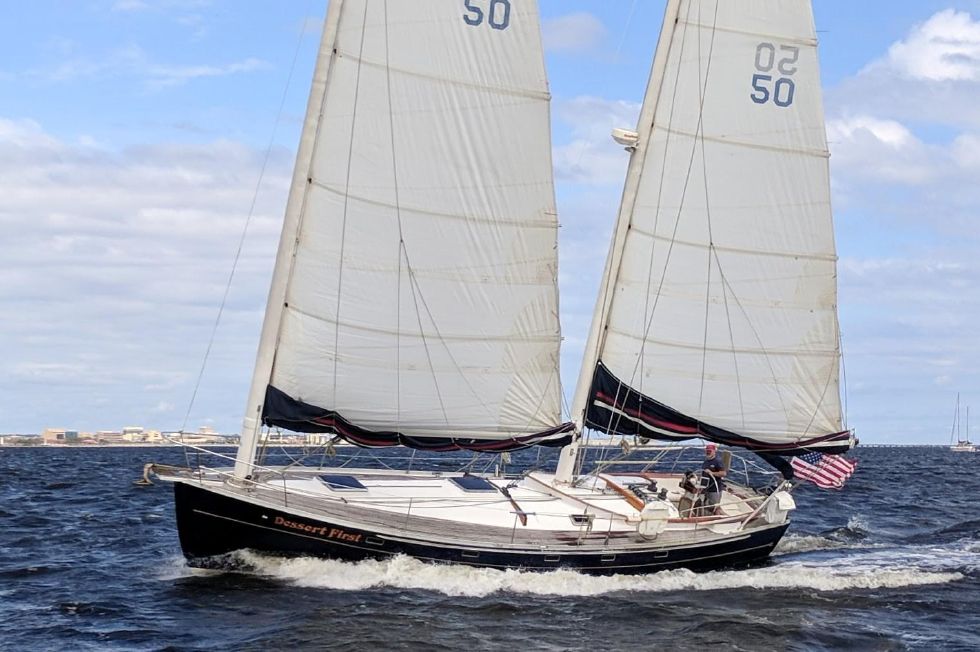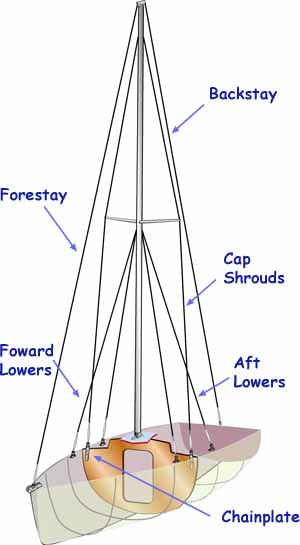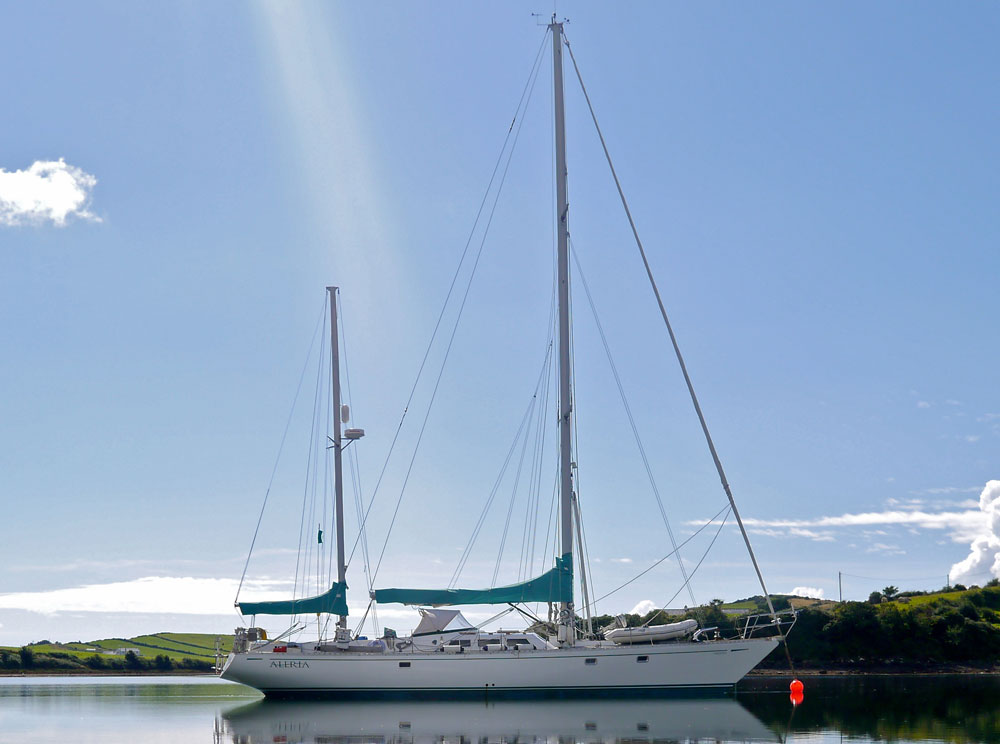Stainless Steel Wire vs. Rod Rigging: Choosing the Right Material for Your Sailboat
In a Nutshell...
When it comes to your sailboat’s standing rigging, the choice is primarily between stainless steel wire, rod rigging, and modern synthetic materials. Stainless steel wire is the traditional, more affordable, and flexible option, making it ideal for most recreational sailors and cruisers. Rod rigging, on the other hand, is a solid, more aerodynamic choice favoured by performance-oriented sailors and racers due to its superior strength and minimal stretch. For those looking for the ultimate weight savings and ease of inspection, modern synthetics like Dyneema offer a compelling, albeit more expensive, alternative. For most sailboat owners, stainless steel wire remains the practical and reliable choice.
 Probably not the best image to illustrate an article about standing rigging, as this sailboat—a Freedom 44 cat ketch—with its unsupported masts, doesn't have any...
Probably not the best image to illustrate an article about standing rigging, as this sailboat—a Freedom 44 cat ketch—with its unsupported masts, doesn't have any...Table of Contents
 1x19 stainless steel wire, rod rigging, or Dyneema?
1x19 stainless steel wire, rod rigging, or Dyneema?It was after a single-handed passage from Villamoura in Portugal to Gibralter. It had been blowing a bit—well quite a bit actually, a full Levanter howling out of the East. We had been well reefed down and with 'Arry, the Aries Self Steering Gear, doing most of the hard work, it had been tiring and uncomfortable but nothing my Nicholson 32 couldn't handle.
Safely moored alongside in Shepherds Marina, I was doing my post-passage rigging check. All seemed well until I came to the forestay—it was much slacker than it should have been. Closer inspection revealed that the stemhead fitting, to which it was attached, was pulling away from the deck. I had been lucky, very lucky!
Decoding Standing Rigging: What's it all About?
Standing rigging is the system of wires, or rods, that supports a sailboat's mast. Unlike running rigging, which includes ropes and lines used to hoist and trim sails, standing rigging is fixed. Its primary job is to keep the mast upright and properly tuned under a variety of conditions, from a gentle breeze to a full-on gale. The integrity of your standing rigging is paramount to your safety and the longevity of your mast.
 This staysail ketch—a Bowman 57—needs a network of standing rigging to support its two masts...
This staysail ketch—a Bowman 57—needs a network of standing rigging to support its two masts...Stainless Steel Wire Rigging: The Go-To Choice
Stainless steel wire rigging, typically constructed from 1x19 strand wire, has been the standard for decades. This design consists of 19 individual wires woven together into a single strand.
| Pros | Cons |
|---|---|
| Cost-Effective | Less Aerodynamic |
| Flexible & Forgiving | Slightly More Stretch |
| Easy to Source & Maintain | Susceptible to Crevice Corrosion |
| Readily Available | Shorter Lifespan |
| Familiar Technology |
Key Specifications & Considerations
- Construction: 1x19 strand is the most common for standing rigging.
- Material: Type 316 stainless steel is the industry standard due to its corrosion resistance.
- Lifespan: Typically recommended for replacement every 10-15 years, or sooner depending on usage & inspection findings.
- Cost: The most economical option, with an average replacement cost significantly lower than rod or synthetic rigging.
Rod Rigging: The High-Performance Option
Rod rigging uses solid, high-tensile stainless steel rods instead of twisted wires. This material is cold-formed to increase its strength and reduce its diameter. It's often found on high-performance racing yachts and larger cruising boats where minimizing weight aloft and stretch is a priority.
Rod Rigging: The High-Performance Option
| Pros | Cons |
|---|---|
| Superior Strength | Higher Initial Cost |
| Less Stretch | Specialised Skills for Installation |
| More Aerodynamic | Susceptible to Metal Fatigue |
| Longer Lifespan | Less Forgiving |
| Lower Weight Aloft | Difficult to Inspect for Cracks |
Key Specifications & Considerations
- Construction: Solid rods of varying diameters, specific to the boat's rig design.
- Material: Typically a higher-grade stainless steel alloy than wire.
- Lifespan: Can last 15-20 years or more with proper inspection.
- Cost: Significantly more expensive than wire rigging, both in materials and installation.
Synthetic Rigging: The Lightweight & Modern Option
In recent years, synthetic fibres have become a viable and increasingly popular option for standing rigging, particularly in racing and high-end cruising circles. The most common material is Dyneema, a high-modulus polyethylene (HMPE) fibre known for its incredible strength-to-weight ratio.
| Pros | Cons |
|---|---|
| Extremely Lightweight | Higher Initial Cost than Wire |
| Comparable Strength to Steel | Susceptible to Chafe & UV Degradation |
| Corrosion-Free | Creep (Elongation under constant load) |
| Excellent for Inspection | Requires Specialised Terminations |
| Easily Repaired |
Key Specifications & Considerations
- Construction: Typically a single braided line, often with a protective cover.
- Material: Dyneema (UHMWPE) is the most common, available in different grades like SK78, SK90, and SK99.
- Lifespan: Can be a long-lasting option, though manufacturers may recommend replacement based on mileage or time, and visual inspection is key.
- Cost: Generally more expensive than stainless steel wire but can be comparable to, or even less than, rod rigging depending on the system.
Standing Rigging: A Direct Comparison
| Feature | Stainless Steel Wire | Rod Rigging | Synthetic Rigging |
|---|---|---|---|
| Material | Twisted 1x19 strands | Solid Rods | HMPE (e.g., Dyneema) |
| Flexibility | Flexible | Stiff | Flexible, with minimal stretch |
| Cost | Lower | Higher | High |
| Lifespan | 10-15 years | 15-20+ years | Varies, can be long with care |
| Aerodynamics | Less efficient | More efficient | Very efficient |
| Stretch | Some stretch | Minimal stretch | Minimal stretch/creep |
| Suitability | Cruisers, Day Sailors | Racers, High-Performance Yachts | Racers, Performance Cruisers |
This comparison chart is a useful tool for sailors, but for a comprehensive overview of all aspects of sailboat rigging, you can return to our A-Z of Sailboat Rigging & Maintenance Guide.
The Bottom Line: Making Your Choice
The decision between stainless steel wire, rod rigging, and synthetic rigging ultimately comes down to your sailing goals. For the vast majority of recreational sailors, cruisers, and liveaboards, stainless steel wire rigging is the clear winner. It's affordable, reliable, and easy to maintain.
If you’re a serious racer or a performance-oriented sailor where every ounce of weight and every fraction of a knot matters, then rod or synthetic rigging are the superior choices. Rod offers stiffness and minimal stretch, while modern synthetics provide the ultimate in weight savings. Both are significant investments, but they deliver a highly tuned, efficient rig that translates to better boat speed and performance. Synthetic rigging also offers the benefit of easier inspection and repairability, a major plus for anyone venturing far offshore.
Article written by Dick McClary, RYA Yachtmaster & Yachting Journalists Association (YJA) member.
Frequently Asked Questions (FAQ)
How often should I inspect my standing rigging?
How often should I inspect my standing rigging?
A full inspection should be performed at least once a year. A professional rig inspection is recommended every 3-5 years, or after a major event like a knockdown.
What are the signs that my rigging needs to be replaced?
What are the signs that my rigging needs to be replaced?
For wire, look for broken strands ("fishhooks"), rust, or corrosion. For rod, be vigilant for signs of metal fatigue or bent terminals. For synthetic, check for chafe, discolouration, or 'fuzziness' on the line.
Can I mix and match rigging materials?
Can I mix and match rigging materials?
While technically possible, it is not recommended. A consistent rig is crucial for proper tuning and load distribution. Stick to one material for your entire standing rigging system.
Is it safe to buy second-hand rigging?
Is it safe to buy second-hand rigging?
Never. The history of the rigging is unknown, and it could have hidden damage or be past its service life. The risk of rig failure far outweighs any potential cost savings.
Recent Articles
-
Hans Christian 43: Classic Bluewater Cruiser & Liveaboard Sailboat
Dec 10, 25 04:37 AM
Explore the Hans Christian 43: a legendary heavy-displacement, long-keel sailboat. Read our in-depth review of its specs, design ratios, and suitability for offshore cruising and living aboard. -
Planning Your Sailboat Liveaboard Lifestyle: An Ocean Sailor's Guide
Dec 06, 25 05:18 AM
Seasoned sailors share their methodical risk analysis for planning a secure Sailboat Liveaboard Lifestyle, covering financial, property, and relationship risks. -
Marine Cabin Heaters: The Expert’s Guide to Comfort & Safety at Sea
Dec 05, 25 06:52 AM
Choose the best Marine Cabin Heaters for your vessel. Expert advice on diesel, paraffin, and hot water systems for year-round cruising comfort.












